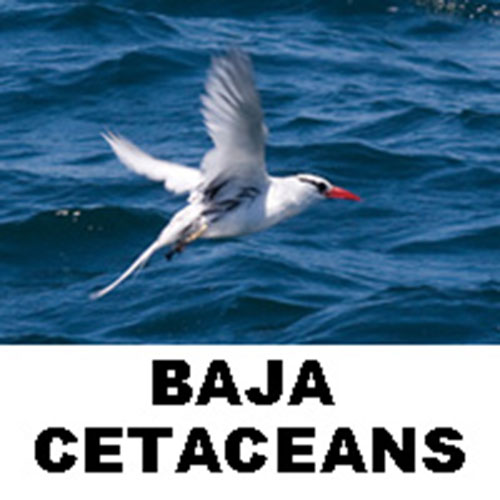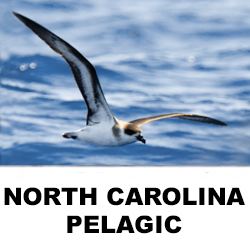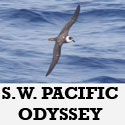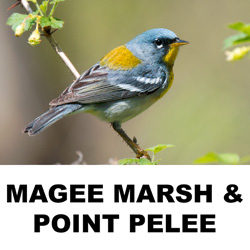|
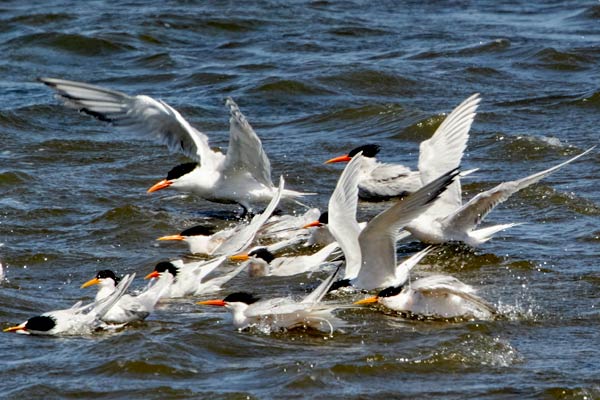 This was sadly Mike's last trip abroad, we had re-arranged it three times due to Covid. There are really only two "windows" during which to visit Arizona, April-May, and July. We tried both, but
this was the first one we were allowed to travel. Even then we had a last-minute scare when I tested positive for Covid about ten days before we were due to fly. No symptoms, but a positive
result from the test. Thankfully I was all-clear by the next week, so we were finally off! The main object of the trip was Arizona specialities, however I wanted to photograph Mountain Plover and there
were several species in California which would be new for Mike so we decided on an extended trip. We spent a few days in California and then flew to Denver, picking up a new hire car there
and made our way slowly south to Arizona, two weeks there and we drove back to Los Angeles for our flights home. Due to the vagaries of hire-car pricing, it was cheaper to have two cars and fly to Denver,
plus it saved several days driving without much birding.
This was sadly Mike's last trip abroad, we had re-arranged it three times due to Covid. There are really only two "windows" during which to visit Arizona, April-May, and July. We tried both, but
this was the first one we were allowed to travel. Even then we had a last-minute scare when I tested positive for Covid about ten days before we were due to fly. No symptoms, but a positive
result from the test. Thankfully I was all-clear by the next week, so we were finally off! The main object of the trip was Arizona specialities, however I wanted to photograph Mountain Plover and there
were several species in California which would be new for Mike so we decided on an extended trip. We spent a few days in California and then flew to Denver, picking up a new hire car there
and made our way slowly south to Arizona, two weeks there and we drove back to Los Angeles for our flights home. Due to the vagaries of hire-car pricing, it was cheaper to have two cars and fly to Denver,
plus it saved several days driving without much birding.
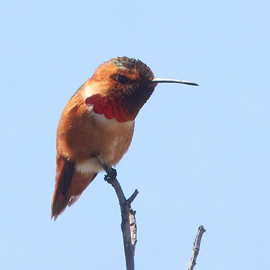 Monday 11th April.
Monday 11th April.
An uneventful flight from Heathrow saw us arrive in LA early afternoon, and quickly clearing customs (a miracle in itself) we picked up a small hire car and headed to our first hotel. Traffic was
unusually light and we got there in time for some birding. I had picked a hotel close to Bolsa Chica lagoon, where I had been many years ago, so we had some time for birding (sleep and food could come later).
The reserve is much larger now with far more access, but we didn't go far, just familiarised ourselves with a few California birds, including Caspian Tern, Northern Rough-winged Swallow, and California
Towhee. It did mean we knew where to go, and park, the next day.
Tuesday 12th April.
An early start saw us walking the trail which goes around the reserve, where we soon saw waders such as Western and Least Sandpipers, Marbled Godwit, Western Willet, and a few
ducks such as Gadwall, Ruddy Duck, Bufflehead and Greater Scaup. As we went further the trail splits, and we were able to loop round to encompass other habitats and eventually
return to our starting point. A Forster's Tern gave good views, and we eventually encountered American Avocets, although I had expected more than one or two. Another bird to have
been "lost" since my 1988 visit was Cinnamon Teal, which was one of Mike's targets, thankfully we encountered them later. Our hummingbird list, which was of special interest on
this trip, began with Anna's, Allen's and Rufous. The latter two present an identification challenge, but in both cases we saw males and are certain we correctly identified a
Rufous, the rarer of the two in California, being only a passage migrant. An Osprey perched above the path was happy to ignore us while I photographed it, and we then proceeded
to another area where the main Elegant Tern colony is situated. Far more numerous than forty years ago, this is the only reliable area in the USA to see these birds, and a few Royals
give an identification challenge. An added bonus came in the shape of an immature Glaucous-winged Gull, nowadays most have moved north by April. A few waders were around, notably a
Long-billed Curlew.
Later in the day we visited Huntington Beach, as we wanted to "check it out" prior to a search for Snowy Plover the following day. There are
always gulls on the beach, and Western and California Gulls showed well, plus a few immature Heermann's Gulls. Sadly no adults were in evidence, but they can often be seen here.
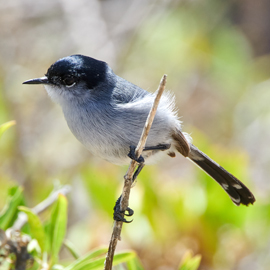 Wednesday 13th April.
Wednesday 13th April.
Although a few pairs breed on the reserve, we had not seen any Snowy Plovers, so returned to the beach to search. It was apparent that the main area was well south of the car park,
but we were lucky in seeing a few birds without too much of a walk. Formerly lumped with Kentish Plover, this pale bird suffers from the usual disturbance problems that any beach
nesting plover has, and it can be difficult to find, but this seems to be a reliable area. Other waders included Sanderling, as ever, and others we had seen at Bolsa Chica. A large
flock of Elegant and Royal Terns also kept us entertained, and a large flock of Western Grebes was offshore, among which we managed to pick out a few Clarks's, although we were to
see both much better later.Our afternoon was spent at several spots nearby (aided by ebird) to pick up a few species we would not see outside California. Chief among these was
California Gnatcatcher, range-restricted and vulnerable, and also California Quail, Towhee and Thrasher, all of these being fairly common. Wrentit proved elusive until we were about to get in the car,
the only downside to the day was that we went to a spot for Black Oystercatcher and any lingering Tattlers or Black Turnstones, and found it to be private. I knew of another spot were I
had seen the oystercatchers previously, but it meant driving north of LA, so we decided to leave those for another trip. There were other California specialities but as the main focus of our
trip was Arizona we were happy with our two days and decided to head towards the St. Gabriel mountains. We booked a Motel 6 at a place called St. Dimas, which was a slightly better standard
than most, and OK for a night, intending to head up the road to Mount Baldy the following day.
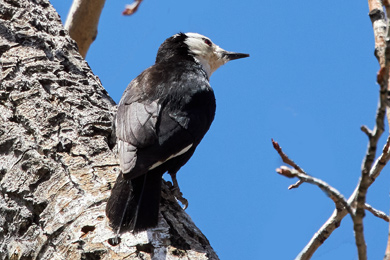 Thursday 14th April
Thursday 14th April
An early start saw us driving up the Mount Baldy Road, our intention being to visit the Mount Baldy Wilderness Preserve, where our main target was White-headed Woodpecker. With only a
day at our disposal we wanted to access some higher elevations with a view to increasing the trip list, and the woodpecker isn't found in Arizona or Colorado, so the plan was to drive
up the road stopping at likely looking spots. In the event we only stopped once or twice as it wasn't practical, but birding was good for commoner species. A pull-off to a maintenace
site had a small area on the edge of the road opposite with a shelter, presumably a sort of rest halt. We discovered Band-tailed Pigeons which showed very well, not always the case.
Whilst there an elderly lady pulled in and threw grain on the ground, which explained the pigeons. She said that she had been doing it daily for years, and it definitely helped our birding
endeavours. Around the area we had seen a few birds, these now appeared right in front of us. They included Golden-crowned Sparrow, Oregon Junco (subspecies of Dark-eyed), Western Scrub-jay,
Black-headed Grosbeak, Spotted Towhee, White-breasted Nuthatch and Oak Titmouse. Whilst most would be seen later in our trip, the Titmouse doesn't occur further East, being replaced by Juniper Titmouse, and the
Sparrow and Pigeon would be unlikely.We eventually reached the Wilderness Preserve, the visitor centre and the surrounding area were all but deserted in April but looked potentially
good. There is a trail which climbs much higher and offers a greater variety of mountain species, but we had neither the time nor the inclination. We still found a good number of species,
White-headed Woodpecker appeared almost immediately, but photographing it was to prove more difficult, since at least six birds were flying around, but landed high in the trees and continually
moved on, often out of sight. Much easier were Acorn Woodpeckers, and we also recorded our first Western Bluebirds. Our first Swainson's Hawk and Red-tailed Hawks flew over during the day,
and we returned to a Motel 6 in a suburb called Inglewood, ready to fly out the next morning to Denver. The motel was within walking distance of the car hire drop-off, so all ran smoothly.
Friday 15th April
We were grateful not to have to spend any longer than necessary at the motel, so were up early and duly caught our flight with Southwest Airlines to Denver. Our intention was to visit Pawnee Grasslands,
which usually holds several species which I, in particular, wanted to see. One of these was Mountain Plover, but far from being common, we could only find a couple of sightings on e-bird, and none was in
the grasslands. We decided to go to a small place, which had a name (Briggsdale) but couldn't be called a town, in the middle of an agricultural area. We found the field in question and thankfully there
were a few Mountain Plovers there, albeit rather distant, but this does seem to be normal for the species. A few Killdeer were present also.
I managed to get a few photos, which was an improvement on my earlier effort to see wintering birds in California four years previously, when I had seen them only in flight. There was little else
around except a Sage Thrasher, which we hadn't expected and was very welcome. Somewhat different to all the other thrashers, but not always easy to catch up with. A Northern Flicker entertained us and a Say's
Phoebe came for a closer look, very happy with the plovers we looked for the road to Pawnee Grasslands for the following day, and then went to our motel in Fort Morgan. Always alert whilst driving, we had
some nice views of Pronghorn Antelope, whilst photographing them a group of four American White Pelican flew over, the only ones of the trip. The curious appendage on the top mandible acquired in breeding plumage
was visible even in flight.

 Saturday 16th April
Saturday 16th April
Getting up early we drove straight to Pawnee Grasslands, where there is a driving trail with various stopping points, although you can stop more or less anywhere. It was to prove a great disappointment,
we had re-jigged the trip so often that we had arrived a couple of weeks earlier that we should have. Many of the birds here are migrants, and unseasonally cold weather seemed to have held them up. We
saw no more Mountain Plovers, but struggled to find the targets for the trip. The only species in good numbers were Horned Larks, and there did seem to be several subspecies around. Other passerines
included Rock Wren, Western Meadowlark, American Pipit and Vesper and Chipping Sparrows, but we could not find any Longspurs, nor Lark Buntings. The only real interest came from raptors, of which several
Ferruginous Hawks were the highlight, and a perched Merlin a close second. Swainson's and Red-tailed Hawks at least gave us something to look at, along with Northern Harriers and American Kestrel. Becoming more than a little fed up, we had
one last look at a flock of small birds, most of which turned out to be Horned Larks (again!) However, two which caught our eyes were McCown's Longspurs, scant reward for several hours of looking, but
strangely the one we had expected to miss if any, Lark Buntings and Chestnut-crowned Longspurs are far commoner when spring finally arrives.
We decided to cut short our visit and change our plans for the following day, as there seemed more birding to be had before taking to the mountains, so we drove straight to our hotel in Limon and discussed things
over dinner, checking out a site on the way which we had decided to possibly visit the next day.
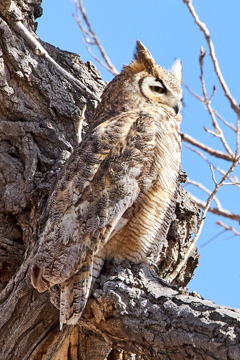 Sunday 17th April
Sunday 17th April
Our original intention had been to get up at "silly o'clock" in order to be at a lek site for Gunnison Sage Grouse by 5am. As things hadn't been going too well, and Mike isn't a great lover of "chickens" plus
it was cold enough to seriously affect the gonads of a brazen arthropod, we planned to do some birding just north of Limon, in order to see Burrowing Owl, which was a target for Mike. Frankly I had expected
to have seen them by now, based on past experiences with them, but it seems they are in decline somewhat.
We drove back north slightly to an area which held Burrowing Owls, according to e-bird, and although we saw three they were sadly distant. We did however see our first Prairie Dogs, with which the owls
often associate as they use old burrows for nesting. On the other side of the road was another Mountain Plover, much closer but
unfortunately against the light, so we had good views but not the stunning photos I had hoped for. We met an American couple, who told us about Chico Basin ranch further down the road which welcomed
birders, and whilst talking to them the plover disappeared, probably flying off, leaving Killdeers only in the field. What happened next raised the mood more than somewhat, the ranch was a really great
spot, and we can't understand why we had never heard of it, although it's relative proximity to Pawnee Grasslands probably means only locals visit. It is an area of grassland with scattered woodland and ponds,
and whilst nothing was exceptionally rare, we recorded a good number of species new for the trip. Thanks are due to a young lady (young compared to us anyway!) who told us of a Great Horned Owl in a tree just
around the corner. It was a tick for Mike, and actually moving around in broad daylight, giving superb views. It flew between trees at least twice, but didn't seem to mind our prescence as we birded on
the water's edge. We didn't cover a huge area, but soon recorded several wildfowl, including Redhead, Cinnamon Teal that Mike was hoping to see, both Scaups, Ring-necked Duck and American Wigeon.
Pied-billed and Black-necked Grebes were out on the water, and a Killdeer paraded right in front of the camera.
Chico Basin is a migration hotspot for the area, although it's situation in Colorado precludes the massed warblers such as occur at Pelee etc., we were at the wrong time but did see a Grey Catbird. Other
passerines included our first Red-winged Blackbirds (you can't avoid them for long), small flocks of Yellow-headed Blackbirds, which we had struggled with in the past, and Great-tailed and Common Grackles.
Moving to another area, a very muddy field, gave us both Yellowlegs, American Pipit and more Shorelarks. Because many of the trees were dead there seemed to be quite a few Woodpeckers, we recorded our first
Ladder-backed and Hairy, managing to get photos of both, which wasn't easy given the twigs around. After a pleasant few hours we continued towards our planned stop for the night at the Monarch Mountain Lodge
on the main road en route to Gunnison and Black Canyon. Ferruginous Hawk passed overhead, as did our only Prairie Falcon, and we began to see both Canada and Cackling Geese. We expected to be seeing some
mountain species around the lodge, and would be able to explore the area where the Gunnison Sage Grouse breed, in the hope of seeing one away from the lek.
Monday 18th April
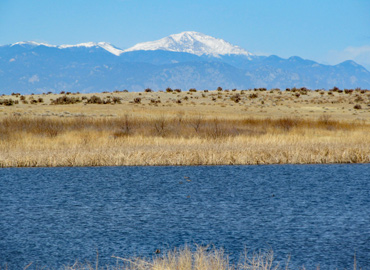
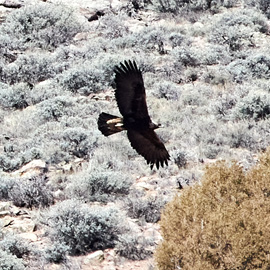 As we perhaps expected, the Lodge was a bit of a ski resort, with attendant high prices and arrogant staff as it was off-season. However there was still plenty of snow around but all the roads were clear,
so we were hoping for some difficult species to show. Sadly this didn't happen, although weather conditions were good nothing seemed to be around except a lone American Robin, Magpie and a few Ravens.
We stopped at various likely looking areas, and searched the sagebush where the grouse live (from the roads, size 9's aren't what an endangered species wants to see in the breeding season). In addition a
river ran alongside the road in places, several spots would have been ideal for American Dipper, and they are known to breed along the river, but today was just one of those days, and
all we saw were Cackling and Canada Geese, and Mallards. We had a drive of about 250 miles so couldn't stop too often, as we came out of the forested areas a few birds appeared and one which I particularly
wanted to photograph was sitting on a roadside fencepost, a Mountain Bluebird. So we stopped, but despite seeing it several times in a grove on the opposite side of the road it managed to elude the camera.
Eventually a Western Bluebird appeared, whether it had chased its more subtly coloured cousin off we don't know, but as we returned to the car we saw a Northern Goshawk on the ridge above us. This disappeared
quickly due to a totally unexpected pair of Golden Eagles, which looked as if they were about to nest in the area judging by their behaviour. One remained on view quite some time, although distant I managed
a few record shots, so at least got something out of the day. As we neared our overnight destination we added Violet-green Swallow to the list, but had we done the whole trip "in reverse" I feel we would have
seen far more species as a few degrees warmer would have resulted in more bird activity. However, the main reason for the trip was to visit Arizona, it would have been better in retrospect to have done a
separate tour to Colorado. One of the other reasons for our route was to see California Condor, and this was to be our next target after another day of mainly travelling.
As we perhaps expected, the Lodge was a bit of a ski resort, with attendant high prices and arrogant staff as it was off-season. However there was still plenty of snow around but all the roads were clear,
so we were hoping for some difficult species to show. Sadly this didn't happen, although weather conditions were good nothing seemed to be around except a lone American Robin, Magpie and a few Ravens.
We stopped at various likely looking areas, and searched the sagebush where the grouse live (from the roads, size 9's aren't what an endangered species wants to see in the breeding season). In addition a
river ran alongside the road in places, several spots would have been ideal for American Dipper, and they are known to breed along the river, but today was just one of those days, and
all we saw were Cackling and Canada Geese, and Mallards. We had a drive of about 250 miles so couldn't stop too often, as we came out of the forested areas a few birds appeared and one which I particularly
wanted to photograph was sitting on a roadside fencepost, a Mountain Bluebird. So we stopped, but despite seeing it several times in a grove on the opposite side of the road it managed to elude the camera.
Eventually a Western Bluebird appeared, whether it had chased its more subtly coloured cousin off we don't know, but as we returned to the car we saw a Northern Goshawk on the ridge above us. This disappeared
quickly due to a totally unexpected pair of Golden Eagles, which looked as if they were about to nest in the area judging by their behaviour. One remained on view quite some time, although distant I managed
a few record shots, so at least got something out of the day. As we neared our overnight destination we added Violet-green Swallow to the list, but had we done the whole trip "in reverse" I feel we would have
seen far more species as a few degrees warmer would have resulted in more bird activity. However, the main reason for the trip was to visit Arizona, it would have been better in retrospect to have done a
separate tour to Colorado. One of the other reasons for our route was to see California Condor, and this was to be our next target after another day of mainly travelling.
Tuesday 19th April
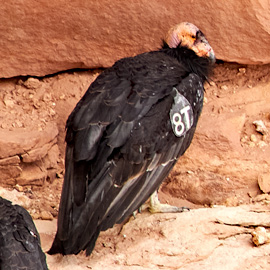
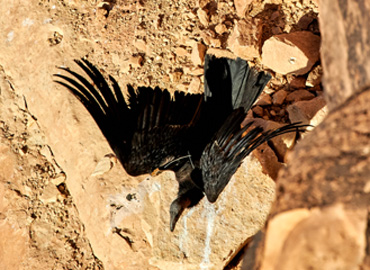
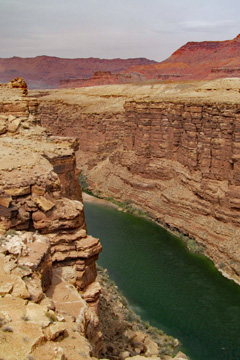 We weren't expecting to see a lot of birds today as we intended to drive to Historic Navajo Bridge to see California Condor. This is probably now the easiest and most reliable place to see them but, being on
the edge of the Grand Canyon National Park it is in a somewhat bird-free zone, and we didn't see much except Red-tailed Hawks on our journey, which was another drive of 250 miles plus. However it did mean we
had plenty of time at the bridge in case of any difficulty with the Condors. Historic Navajo Bridge isn't really that historic, it was completed in 1929 and replaced by the current bridge which carries the
main road and was opened in 1995. However it was important when it was built, replacing the ferry which crossed the Colorado River. As the ferry sank several months before the bridge completion it meant a
journey of 800 miles to get between Utah and Arizona because there were so few crossings of the river! Our hotel for the night was Lee's Ferry Lodge, commemorating the original ferry operator. The old bridge
is now open to pedestrians, and has become a roosting area for Condors. We saw several within minutes of our arrival, on rocks well below us, the bridge being nearly 500 feet above the river. There were a few
other birds in the area, notably White-throated Swifts, but we didn't linger too long as our hotel was close by and we were to return the following morning.
We weren't expecting to see a lot of birds today as we intended to drive to Historic Navajo Bridge to see California Condor. This is probably now the easiest and most reliable place to see them but, being on
the edge of the Grand Canyon National Park it is in a somewhat bird-free zone, and we didn't see much except Red-tailed Hawks on our journey, which was another drive of 250 miles plus. However it did mean we
had plenty of time at the bridge in case of any difficulty with the Condors. Historic Navajo Bridge isn't really that historic, it was completed in 1929 and replaced by the current bridge which carries the
main road and was opened in 1995. However it was important when it was built, replacing the ferry which crossed the Colorado River. As the ferry sank several months before the bridge completion it meant a
journey of 800 miles to get between Utah and Arizona because there were so few crossings of the river! Our hotel for the night was Lee's Ferry Lodge, commemorating the original ferry operator. The old bridge
is now open to pedestrians, and has become a roosting area for Condors. We saw several within minutes of our arrival, on rocks well below us, the bridge being nearly 500 feet above the river. There were a few
other birds in the area, notably White-throated Swifts, but we didn't linger too long as our hotel was close by and we were to return the following morning.
Wednesday and Thursday 20th/21st April
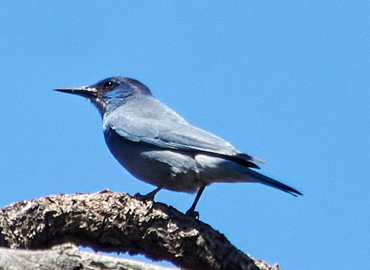 These two days were really about "repositioning" to get to South-eastern Arizona, which was the main part of the trip. Whilst The Flagstaff area has many sites there are few species which cannot be seen further
south, and whilst a trip could be based around the area, the southern part of the state is where most birders visit, and where the rest of our trip was to be.
We awoke early the following morning, and had a look around our motel, which was in the middle of nowhere, but had a superb view of Vermilion Cliffs opposite. A few trees at the rear held small numbers of
Myrtle Warblers; Say's Phoebe and White-crowned Sparrow were also in evidence. A return to the bridge gave us more views of California Condors, but little else, even the White-throated Swifts had (presumably)
gone higher in search of insects. Having got the Condors, which was the reason for this particular route, we intended to enter Arizona and spend three days driving south birding en route. We first headed
for Humphrey's Peak, just north of Flagstaff, in search of higher altitude species again. We did fare somewhat better than in Colorado, but things were very slow on our first day. We began with Turkey Vulture,
which we were to see every day thereafter, Swainson's and Red-tailed Hawks also showed near the Condor site. As we continued south we saw little until almost at Humphrey's Peak, this being the first wooded
area we came to. Again, birding was slow, but these are vast areas of woodland, and most of the birds had stopped singing and were actively nesting at the time of our visit. Stellers Jay, Ruby-crowned Kinglet,
Hairy Woodpecker, Chipping Sparrow, Audubon's Warbler and Brewers Blackbird were about it, with one exception, which was a tick for both of us. That was a Graces Warbler, sadly views were brief and high in the trees, we had expected
them to be quite common, but that proved not to be the case. Having previously visited Magee and Pelee, warblers were high on our target list, especially the five or six that are rarely found outside Arizona.
On our second day we had one particular target species, but didn't visit any specific sites. Naturally it proved difficult, but eventually we did get brief views of Lewis' Woodpecker, an unusual woodpecker that
seems to be getting harder to find. There used to be regular sites around Flagstaff, but the "easiest" ones seem to be gone, so we just looked in any likely areas, and eventually caught up with a bird that did
its best not to be caught up with! I had seen them many years ago in California, but for Mike it was a much wanted tick. In fact we did very well with peckers overall, recording a total of eleven species.
These two days were really about "repositioning" to get to South-eastern Arizona, which was the main part of the trip. Whilst The Flagstaff area has many sites there are few species which cannot be seen further
south, and whilst a trip could be based around the area, the southern part of the state is where most birders visit, and where the rest of our trip was to be.
We awoke early the following morning, and had a look around our motel, which was in the middle of nowhere, but had a superb view of Vermilion Cliffs opposite. A few trees at the rear held small numbers of
Myrtle Warblers; Say's Phoebe and White-crowned Sparrow were also in evidence. A return to the bridge gave us more views of California Condors, but little else, even the White-throated Swifts had (presumably)
gone higher in search of insects. Having got the Condors, which was the reason for this particular route, we intended to enter Arizona and spend three days driving south birding en route. We first headed
for Humphrey's Peak, just north of Flagstaff, in search of higher altitude species again. We did fare somewhat better than in Colorado, but things were very slow on our first day. We began with Turkey Vulture,
which we were to see every day thereafter, Swainson's and Red-tailed Hawks also showed near the Condor site. As we continued south we saw little until almost at Humphrey's Peak, this being the first wooded
area we came to. Again, birding was slow, but these are vast areas of woodland, and most of the birds had stopped singing and were actively nesting at the time of our visit. Stellers Jay, Ruby-crowned Kinglet,
Hairy Woodpecker, Chipping Sparrow, Audubon's Warbler and Brewers Blackbird were about it, with one exception, which was a tick for both of us. That was a Graces Warbler, sadly views were brief and high in the trees, we had expected
them to be quite common, but that proved not to be the case. Having previously visited Magee and Pelee, warblers were high on our target list, especially the five or six that are rarely found outside Arizona.
On our second day we had one particular target species, but didn't visit any specific sites. Naturally it proved difficult, but eventually we did get brief views of Lewis' Woodpecker, an unusual woodpecker that
seems to be getting harder to find. There used to be regular sites around Flagstaff, but the "easiest" ones seem to be gone, so we just looked in any likely areas, and eventually caught up with a bird that did
its best not to be caught up with! I had seen them many years ago in California, but for Mike it was a much wanted tick. In fact we did very well with peckers overall, recording a total of eleven species.
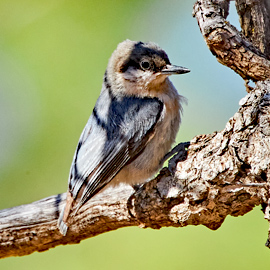 Birding was by now beginning to become a bit more like we were used to in the states, and we in fact also saw our first Gila Woodpecker (much further south) and another Northern Flicker on the same day. We
stayed overnight on the outskirts of Flagstaff, and spent the morning in a suitable area for several targets. We failed there with the Lewis', but saw several birds flying around which quite mystified us. They were
in small flocks, and when they finally stayed still and close enough the penny dropped. Pinyon Jays! This was a bird I had missed on two previous trips, probably because they don't tend to stay in one spot
for long, but they aren't uncommon in the right habitat. We were in a fairly open area and they eventually landed in a tree close enough for some decent photos.
Another target species still eluded us, but as we were watching the jays I saw a bird distantly perched in a tree. It was just too far away to identify in bins, so whilst Mike went to get the scope I took some record shots,
not really expecting much of a result. Of course it flew off before the scope was on it, so we forgot about it, and continued searching as there were plenty of birds around. Only when I was processing my photos
much later did I realise how good mirrorless cameras can be, when I looked at a pefectly acceptable photo of a Townsend's Solitaire, showing all the identification features we couldn't see without a telescope!
However, it was overall a corvid area, we also saw Steller's and Woodhouse's Scrub-jay (a recent split from California Scrub-jay and a much shyer and more solitary species).
That afternoon we stopped at another woodland area at somewhat lower elevation, and recorded two more new birds for the trip, White-breasted and Pygmy Nuthatches. Mike had been searching for Pygmy and
wondering why we hadn't seen one yet, until one spent quite some time right in front of the camera. It was to be the only one we did see in the trip. Mountain Chickadees and Dark-eyed Juncos were also in the area.
Things were finally starting to go our way, but there was
to be an added bonus yet. Ronnies Resort, the motel we had booked, took some time to find, the satnav took us to the address, but it was in the middle of a somewhat upmarket street of quite large houses. It turned out not
to be a resort as we know it, but the upper storey of a house with a separate entrance and a balcony. Our host was a lovely lady, and everything was just like a home. On relaxing on the balcony we rapidly
discovered the garden was attracting a number of birds, including several Lucy's Warblers, another one of our targets. Other birds included a very obliging Spotted Towhee, Lesser Goldfinch, American Robin,
House Finches and White-crowned Sparrow.
Birding was by now beginning to become a bit more like we were used to in the states, and we in fact also saw our first Gila Woodpecker (much further south) and another Northern Flicker on the same day. We
stayed overnight on the outskirts of Flagstaff, and spent the morning in a suitable area for several targets. We failed there with the Lewis', but saw several birds flying around which quite mystified us. They were
in small flocks, and when they finally stayed still and close enough the penny dropped. Pinyon Jays! This was a bird I had missed on two previous trips, probably because they don't tend to stay in one spot
for long, but they aren't uncommon in the right habitat. We were in a fairly open area and they eventually landed in a tree close enough for some decent photos.
Another target species still eluded us, but as we were watching the jays I saw a bird distantly perched in a tree. It was just too far away to identify in bins, so whilst Mike went to get the scope I took some record shots,
not really expecting much of a result. Of course it flew off before the scope was on it, so we forgot about it, and continued searching as there were plenty of birds around. Only when I was processing my photos
much later did I realise how good mirrorless cameras can be, when I looked at a pefectly acceptable photo of a Townsend's Solitaire, showing all the identification features we couldn't see without a telescope!
However, it was overall a corvid area, we also saw Steller's and Woodhouse's Scrub-jay (a recent split from California Scrub-jay and a much shyer and more solitary species).
That afternoon we stopped at another woodland area at somewhat lower elevation, and recorded two more new birds for the trip, White-breasted and Pygmy Nuthatches. Mike had been searching for Pygmy and
wondering why we hadn't seen one yet, until one spent quite some time right in front of the camera. It was to be the only one we did see in the trip. Mountain Chickadees and Dark-eyed Juncos were also in the area.
Things were finally starting to go our way, but there was
to be an added bonus yet. Ronnies Resort, the motel we had booked, took some time to find, the satnav took us to the address, but it was in the middle of a somewhat upmarket street of quite large houses. It turned out not
to be a resort as we know it, but the upper storey of a house with a separate entrance and a balcony. Our host was a lovely lady, and everything was just like a home. On relaxing on the balcony we rapidly
discovered the garden was attracting a number of birds, including several Lucy's Warblers, another one of our targets. Other birds included a very obliging Spotted Towhee, Lesser Goldfinch, American Robin,
House Finches and White-crowned Sparrow.
Friday 22nd April
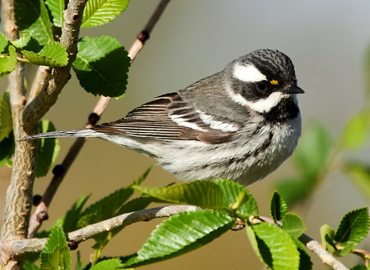 We had finally reached the part of Arizona where most of the tour companies go, and our first real site was to be a drive up the Mount Ord road, which is some way north of Phoenix and a bit isolated, but just off the
direct route to the Tuscon area. Birds are supposedly quite varied and as you drive up from the start of the road the habitat and fauna changes with altitude. Most tours from abroad don't visit it, but a lot
of locals do, and as we were coming from the north decided to give it a try. The road gradually increases in elevation, at the "bottom" we recorded our first Phainopepla and Gambell's Quail of the trip, and at the top,
a distance of about nineteen miles, Wild Turkey. Birding wasn't easy, but we did build our list slowly but surely. Black Phoebe, Dusky and Cordilleran Flycatchers, Western Kingbird and Ash-throated Flycatcher
represented Tyrant Flycatchers, and hirundines included Cliff, Northern Rough-winged and Violet-green Swallows. Brewer's Sparrow was our only one of the trip, whereas Scotts and Hooded Orioles were the first of many.
Our main reason for visiting the area was to increase our warbler list, and we recorded more Lucy's, Virginia's and Nashville, again our only one of the trip. Audubon's and several really showy Black-throated Greys,
a western species and a tick for Mike, completed the list. Slowly but surely the warblers were being recorded, sadly photography wasn't easy, but I did get some nice Black-throated Grey shots. Our first Arizona
hummingbird also put in an appearence, Black-chinned, in fact we were overall more succesful with hummers than any other group, but they are after all one of the main reasons to visit Arizona.
Back on the main highway driving south we saw a huge lake on our left, Theodore Rooseveldt Lake. We decided to take a look as it was still only mid-afternoon. This proved to be a good plan, as it turned out to hold several pairs of both
Western and Clark's Grebes, enabling a good comparison of the two species, backed up by photos. A number of Northern Rough-winged Swallows perched in a nearby tree, and an Osprey flew over. Great and Snowy Egrets and Great Blue Heron were present,
amazingly we weren't to see another Egret on the trip except our only Cattle Egret.
We had finally reached the part of Arizona where most of the tour companies go, and our first real site was to be a drive up the Mount Ord road, which is some way north of Phoenix and a bit isolated, but just off the
direct route to the Tuscon area. Birds are supposedly quite varied and as you drive up from the start of the road the habitat and fauna changes with altitude. Most tours from abroad don't visit it, but a lot
of locals do, and as we were coming from the north decided to give it a try. The road gradually increases in elevation, at the "bottom" we recorded our first Phainopepla and Gambell's Quail of the trip, and at the top,
a distance of about nineteen miles, Wild Turkey. Birding wasn't easy, but we did build our list slowly but surely. Black Phoebe, Dusky and Cordilleran Flycatchers, Western Kingbird and Ash-throated Flycatcher
represented Tyrant Flycatchers, and hirundines included Cliff, Northern Rough-winged and Violet-green Swallows. Brewer's Sparrow was our only one of the trip, whereas Scotts and Hooded Orioles were the first of many.
Our main reason for visiting the area was to increase our warbler list, and we recorded more Lucy's, Virginia's and Nashville, again our only one of the trip. Audubon's and several really showy Black-throated Greys,
a western species and a tick for Mike, completed the list. Slowly but surely the warblers were being recorded, sadly photography wasn't easy, but I did get some nice Black-throated Grey shots. Our first Arizona
hummingbird also put in an appearence, Black-chinned, in fact we were overall more succesful with hummers than any other group, but they are after all one of the main reasons to visit Arizona.
Back on the main highway driving south we saw a huge lake on our left, Theodore Rooseveldt Lake. We decided to take a look as it was still only mid-afternoon. This proved to be a good plan, as it turned out to hold several pairs of both
Western and Clark's Grebes, enabling a good comparison of the two species, backed up by photos. A number of Northern Rough-winged Swallows perched in a nearby tree, and an Osprey flew over. Great and Snowy Egrets and Great Blue Heron were present,
amazingly we weren't to see another Egret on the trip except our only Cattle Egret.
Saturday 23rd April
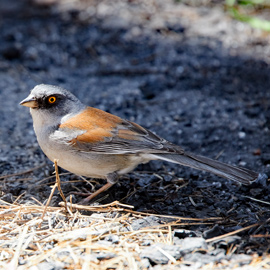
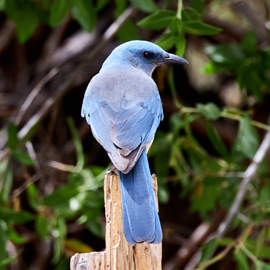 A somewhat frustrating day as we drove from Globe to Benson via Mount Lemmon, but we had to make the decision to miss Aravaipa Canyon and other good areas north of Tuscon. We did
have a good start however, as an Abert's Towhee was hopping around the grounds of our motel.
Mount Lemmon has a lot of potential and it is probably the number one site for Tuscon residents. A twisting road runs over a distance of twenty-five miles to the peak, at an elevation of
just over 9000 feet. Driving south from Globe we passed through the town of Dudleyville, which is, or was, a site for Mississippi Kites. We saw none, but having seen them in both North
Carolina and Pelee (a rarity there) weren't too bothered. However we did see a White-tailed Kite, which was a bonus as they are quite range-restricted in the states and
rarely seen in Arizona.Like many places in Arizona, Mount Lemmon has vast areas of habitat, so finding birds wasn't particularly easy, but we did record several new birds
for the trip, including Yellow-eyed Junco, Cassin's Kingbird, Grey (a difficult one) and Plumbeous Vireos, Mexican Jay and Townsend's Warbler. We hadn't expected too many Townsend's and
Hermit Warblers as they are only migrants here, but Townsend's proved quite common. We began to see hummers again, Rivoli's and Broad-billed were new but the first of many. Some of these
birds we expected to see in greater numbers later, and we did, but Yellow-eyed Junco, which is really a Mexican species with a very small US range proved quite scarce, so we were
glad of the good views we had here.Whilst Mount Lemmon is an excellent site, and in truth we could have seen much more, it is not an essential on an Arizona trip, but coming south
from Colorado it made a good days birding. There are so many good sites in Arizona, and only a few species are restricted to one or two. Once south of Tuscon distances aren't great, and
we began to stay at one hotel for two or three nights until the end of the trip. Had we not wanted to see a few specific species such as Mountain Plover and California Condor, the last
part of our trip could have stood alone as a superb destination. I had visited Arizona briefly before which was an added reason for our extended wanderings, although that was earlier in the
year when few summer migrants were around.
A somewhat frustrating day as we drove from Globe to Benson via Mount Lemmon, but we had to make the decision to miss Aravaipa Canyon and other good areas north of Tuscon. We did
have a good start however, as an Abert's Towhee was hopping around the grounds of our motel.
Mount Lemmon has a lot of potential and it is probably the number one site for Tuscon residents. A twisting road runs over a distance of twenty-five miles to the peak, at an elevation of
just over 9000 feet. Driving south from Globe we passed through the town of Dudleyville, which is, or was, a site for Mississippi Kites. We saw none, but having seen them in both North
Carolina and Pelee (a rarity there) weren't too bothered. However we did see a White-tailed Kite, which was a bonus as they are quite range-restricted in the states and
rarely seen in Arizona.Like many places in Arizona, Mount Lemmon has vast areas of habitat, so finding birds wasn't particularly easy, but we did record several new birds
for the trip, including Yellow-eyed Junco, Cassin's Kingbird, Grey (a difficult one) and Plumbeous Vireos, Mexican Jay and Townsend's Warbler. We hadn't expected too many Townsend's and
Hermit Warblers as they are only migrants here, but Townsend's proved quite common. We began to see hummers again, Rivoli's and Broad-billed were new but the first of many. Some of these
birds we expected to see in greater numbers later, and we did, but Yellow-eyed Junco, which is really a Mexican species with a very small US range proved quite scarce, so we were
glad of the good views we had here.Whilst Mount Lemmon is an excellent site, and in truth we could have seen much more, it is not an essential on an Arizona trip, but coming south
from Colorado it made a good days birding. There are so many good sites in Arizona, and only a few species are restricted to one or two. Once south of Tuscon distances aren't great, and
we began to stay at one hotel for two or three nights until the end of the trip. Had we not wanted to see a few specific species such as Mountain Plover and California Condor, the last
part of our trip could have stood alone as a superb destination. I had visited Arizona briefly before which was an added reason for our extended wanderings, although that was earlier in the
year when few summer migrants were around.
Sunday 24th April
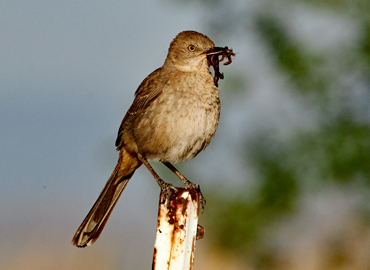 Whilst Benson is a very good area to be based for a few days, it isn't as good as it used to be due to urban development, so we stayed overnight in Willcox which is a little further on.
This gave us access immediately on starting out in the morning to Willcox Twin Lakes golf course and Cochise Lake, a large area of wastewater, which are the best sites for waders and other
waterbirds in the area. We spent most of the day there as there would be few further opportunities for waders. However, almost our first sighting as we got out of the car was Scaled Quail,
a tick for both of us. Rapidly disappearing in to the scrub, it was our only sighting, Gambel's Quail was far commoner (annoyingly so by the end of the trip), but our attention soon moved
to a thrasher which was obviously collecting food for young, and sat very obligingly on a post on several occasions. There are two Thrashers found fairly commonly in Arizona, this was the
less common of the two, Bendire's. It can be difficult to identify but such were the views it was obvious, meaning a lot less scrutiny of thrashers was necessary for the rest of the trip. As we saw
them daily this was a good thing, they were seemingly all Curve-billed and indeed we saw Curve-billeds that same day. All this was standing by the car, there was also some migration going on,
the most numerous birds were Yellow and Wilson's warblers, we also saw a Black-throated Grey and a Common Yellowthroat, seemingly oblivious to us and feeding on the ground. It was to be later
in the day that we saw one of our most-hoped for species, a MacGillivray's Warbler. Not that they are uncommon, but quite secretive, we had reasonable views of one but could not
relocate it as it moved off. Our first Vermilion Flycatcher was welcome, although they were to prove common, and our first Lazuli Bunting. Being near water, Belted Kingfisher was a
possibility, and indeed one showed well not far from the car park. A welcome bonus on the passerine front, whilst walking around the main lake, was a Tropical Kingbird. Whilst I have seen
hundreds in South America, they are rare in the USA, possibly overlooked as they are very similar to others such as Western and Cassin's. It was a tick for Mike, who found it, identified initially
by its forked tail.
Whilst Benson is a very good area to be based for a few days, it isn't as good as it used to be due to urban development, so we stayed overnight in Willcox which is a little further on.
This gave us access immediately on starting out in the morning to Willcox Twin Lakes golf course and Cochise Lake, a large area of wastewater, which are the best sites for waders and other
waterbirds in the area. We spent most of the day there as there would be few further opportunities for waders. However, almost our first sighting as we got out of the car was Scaled Quail,
a tick for both of us. Rapidly disappearing in to the scrub, it was our only sighting, Gambel's Quail was far commoner (annoyingly so by the end of the trip), but our attention soon moved
to a thrasher which was obviously collecting food for young, and sat very obligingly on a post on several occasions. There are two Thrashers found fairly commonly in Arizona, this was the
less common of the two, Bendire's. It can be difficult to identify but such were the views it was obvious, meaning a lot less scrutiny of thrashers was necessary for the rest of the trip. As we saw
them daily this was a good thing, they were seemingly all Curve-billed and indeed we saw Curve-billeds that same day. All this was standing by the car, there was also some migration going on,
the most numerous birds were Yellow and Wilson's warblers, we also saw a Black-throated Grey and a Common Yellowthroat, seemingly oblivious to us and feeding on the ground. It was to be later
in the day that we saw one of our most-hoped for species, a MacGillivray's Warbler. Not that they are uncommon, but quite secretive, we had reasonable views of one but could not
relocate it as it moved off. Our first Vermilion Flycatcher was welcome, although they were to prove common, and our first Lazuli Bunting. Being near water, Belted Kingfisher was a
possibility, and indeed one showed well not far from the car park. A welcome bonus on the passerine front, whilst walking around the main lake, was a Tropical Kingbird. Whilst I have seen
hundreds in South America, they are rare in the USA, possibly overlooked as they are very similar to others such as Western and Cassin's. It was a tick for Mike, who found it, identified initially
by its forked tail.
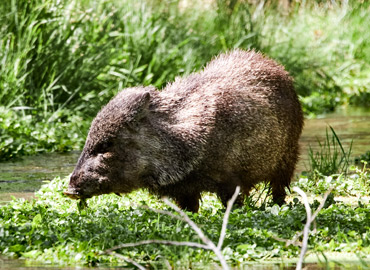 We spent the rest of the day driving/walking round Cochise lake, which would be our last chance for waders and ducks. The only duck that really interested us was Mexican Duck, which we found
on a small pool away from the main body of the lake. As it is not certain that any in the USA are pure, without some Mallard Genes, it rather detracted from the interest, but we were
fascinated by a Great-tailed Grackle which repeatedly "dive-bombed" a female Blue-winged Teal, giving me some great photos. We could only assume it was a territorial dispute, but it was
away from the shore and other ducks were in the vicinity. Other ducks included American Wigeon, Cinnamon Teal etc. but nothing new. However, waders were a somewhat different mix, most new for the trip.
Of most interest to me was Wilson's Snipe, which although I had seen them on other trips I had never photographed. This proved not to be the easiest of tasks and took some time, including a bird
sitting down behind a rock and going to sleep!. Mike was quite happy scoping everything else, and we recorded much better views of American Avocet, Black-necked Stilt, Least, Spotted and Solitary Sandpipers,
and Red-necked and Wilson's Phalaropes, all new for the trip. Solitary Sandpiper is listed as a vagrant, but apparently some non-breeders from the winter populations occur in southern states.
White-faced Ibis were much in evidence, plus a few Black-crowned Night Herons, but a solitary Western Cattle Egret was our last egret of the trip. At the conclusion of an excellent days birding we drove
to our accomodation for the next three nights, at Rodeo Mountain Valley Lodge, near the famous township of Portal. A somewhat strange place, very comfortable but we had to make sure to "shut the
gate to the rooms to keep the Javelinas out". The rooms were very rustic and individual, to say the least.
We spent the rest of the day driving/walking round Cochise lake, which would be our last chance for waders and ducks. The only duck that really interested us was Mexican Duck, which we found
on a small pool away from the main body of the lake. As it is not certain that any in the USA are pure, without some Mallard Genes, it rather detracted from the interest, but we were
fascinated by a Great-tailed Grackle which repeatedly "dive-bombed" a female Blue-winged Teal, giving me some great photos. We could only assume it was a territorial dispute, but it was
away from the shore and other ducks were in the vicinity. Other ducks included American Wigeon, Cinnamon Teal etc. but nothing new. However, waders were a somewhat different mix, most new for the trip.
Of most interest to me was Wilson's Snipe, which although I had seen them on other trips I had never photographed. This proved not to be the easiest of tasks and took some time, including a bird
sitting down behind a rock and going to sleep!. Mike was quite happy scoping everything else, and we recorded much better views of American Avocet, Black-necked Stilt, Least, Spotted and Solitary Sandpipers,
and Red-necked and Wilson's Phalaropes, all new for the trip. Solitary Sandpiper is listed as a vagrant, but apparently some non-breeders from the winter populations occur in southern states.
White-faced Ibis were much in evidence, plus a few Black-crowned Night Herons, but a solitary Western Cattle Egret was our last egret of the trip. At the conclusion of an excellent days birding we drove
to our accomodation for the next three nights, at Rodeo Mountain Valley Lodge, near the famous township of Portal. A somewhat strange place, very comfortable but we had to make sure to "shut the
gate to the rooms to keep the Javelinas out". The rooms were very rustic and individual, to say the least.
Monday 25th April and Tuesday 26th April
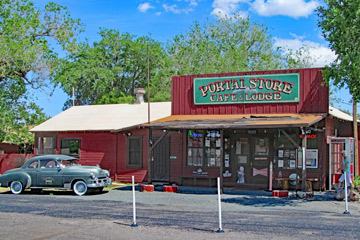
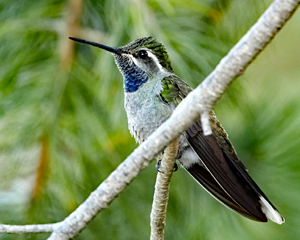
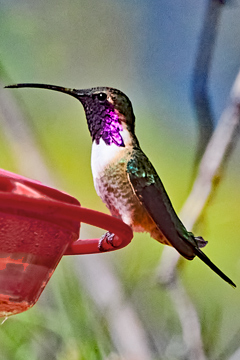 Our accomodation was in one of the remotest parts of Arizona, so much that it was actually in New Mexico. We were about ten miles from Portal, where the only accomodation is above the general store,
and gets booked up by locals well in advance. Portal is a township given over almost entirely to birding, with several gardens having set up feeder stations, and being adjacent to the South fork of
Cave Creek, one of the best known birding locations in the USA. Lying on the east side of the Chiricahua mountains, very little travel is involved for two days of excellent birding. The only concern is
that the nearest petrol is about sixty miles away, and we found that different rules apply to credit cards in New Mexico, so we had to withdraw cash to pay for our Lodge, driving about five miles in to
Arizona to do so (no ATM's in Portal!). So visiting Portal does require a bit of pre-planning, but birding actually started in the grounds of our lodge, and a Cactus Wren greeted us in the morning. A
stop along the road to Portal afforded good views of Greater Roadrunner, which was one of Mike's most wanted birds, also Dusky-capped Flycatcher. Arriving in Portal itself we found hummingbird feeders
outside the general store, and also tiny Inca Doves. We had a look round the township and thence to Dave Jasper's hummingbird feeders, outside his house a few hundred yards away. We were destined to
visit here several times, he has set up chairs in front of the feeders, and anyone is welcome to sit and watch. All he asks is that a donation is made for the cost of filling the feeders, which obviously
everyone does. I don't remember the order of things, we had come mainly for hummers, but Bell's Vireo, Canyon and Green-tailed Towhees and Yellow-breasted Chat, the last two new, as were the first of many Pyrrhuloxias.
But hummingbirds were the main attraction, and the star of the show was a male Lucifer Sheartail, not the easiest to come by these days, but a regular visitor if you waited long enough. Others included Black-chinned,
which were everywhere, Broad-billed and Broad-tailed in good numbers, and a single Blue-throated Mountaingem, which was not at Dave's feeders but showed well at a parking area for Cave Creek. Cave Creek
was notable for numbers of birds, but they were thinly spread as it is a large area. We saw our only Hermit Warbler there, and Hepatic and Western Tanagers on our second day. On that second day we went
further up Cave Creek South fork, and saw our only (surprisingly) Red-faced Warbler of the trip, also Olive, Grace's, Virginia's and Lucy's. A brief Painted Redstart also put in an appearence, but better views
were to be had later. A surprise bonus on our last day was Cassin's Vireo, and we saw a Crissal Thrasher (at Dave's old house, the new owners carry on the feeder tradition), which disappeared in to
the undergrowth. We also visited Cave Creek Ranch, which offers accomodation, and had circumstances been different would make an ideal base for a fortnight. A small gift shop (with some really good t-shirts)
and more feeders were here, but our main reason was to glean information. A local bird guide, James Peterson, was very helpful, and when we enquired about an elf owl nest told us to meet him there at dusk. He was taking a client
and quite happy for us to tag along free of charge, although it turned out that it was only about a hundred yards from the shop. Many of the locals make a living from guiding, Dave Jasper being another.
Guides in this area are not necessary for an experienced birder, but they seem happy to help with information, everyone in the town welcomes birders.
The whole area is a fantastic experience, we were probably a bit late for a lot of warblers
since they had settled in to breed and were far more elusive, plus numbers were low because the region has been badly affected by drought. It would make a great week or fortnight's holiday, especially as
it hasn't changed much since the 1950's, certainly as far as outward appearences go.
Our accomodation was in one of the remotest parts of Arizona, so much that it was actually in New Mexico. We were about ten miles from Portal, where the only accomodation is above the general store,
and gets booked up by locals well in advance. Portal is a township given over almost entirely to birding, with several gardens having set up feeder stations, and being adjacent to the South fork of
Cave Creek, one of the best known birding locations in the USA. Lying on the east side of the Chiricahua mountains, very little travel is involved for two days of excellent birding. The only concern is
that the nearest petrol is about sixty miles away, and we found that different rules apply to credit cards in New Mexico, so we had to withdraw cash to pay for our Lodge, driving about five miles in to
Arizona to do so (no ATM's in Portal!). So visiting Portal does require a bit of pre-planning, but birding actually started in the grounds of our lodge, and a Cactus Wren greeted us in the morning. A
stop along the road to Portal afforded good views of Greater Roadrunner, which was one of Mike's most wanted birds, also Dusky-capped Flycatcher. Arriving in Portal itself we found hummingbird feeders
outside the general store, and also tiny Inca Doves. We had a look round the township and thence to Dave Jasper's hummingbird feeders, outside his house a few hundred yards away. We were destined to
visit here several times, he has set up chairs in front of the feeders, and anyone is welcome to sit and watch. All he asks is that a donation is made for the cost of filling the feeders, which obviously
everyone does. I don't remember the order of things, we had come mainly for hummers, but Bell's Vireo, Canyon and Green-tailed Towhees and Yellow-breasted Chat, the last two new, as were the first of many Pyrrhuloxias.
But hummingbirds were the main attraction, and the star of the show was a male Lucifer Sheartail, not the easiest to come by these days, but a regular visitor if you waited long enough. Others included Black-chinned,
which were everywhere, Broad-billed and Broad-tailed in good numbers, and a single Blue-throated Mountaingem, which was not at Dave's feeders but showed well at a parking area for Cave Creek. Cave Creek
was notable for numbers of birds, but they were thinly spread as it is a large area. We saw our only Hermit Warbler there, and Hepatic and Western Tanagers on our second day. On that second day we went
further up Cave Creek South fork, and saw our only (surprisingly) Red-faced Warbler of the trip, also Olive, Grace's, Virginia's and Lucy's. A brief Painted Redstart also put in an appearence, but better views
were to be had later. A surprise bonus on our last day was Cassin's Vireo, and we saw a Crissal Thrasher (at Dave's old house, the new owners carry on the feeder tradition), which disappeared in to
the undergrowth. We also visited Cave Creek Ranch, which offers accomodation, and had circumstances been different would make an ideal base for a fortnight. A small gift shop (with some really good t-shirts)
and more feeders were here, but our main reason was to glean information. A local bird guide, James Peterson, was very helpful, and when we enquired about an elf owl nest told us to meet him there at dusk. He was taking a client
and quite happy for us to tag along free of charge, although it turned out that it was only about a hundred yards from the shop. Many of the locals make a living from guiding, Dave Jasper being another.
Guides in this area are not necessary for an experienced birder, but they seem happy to help with information, everyone in the town welcomes birders.
The whole area is a fantastic experience, we were probably a bit late for a lot of warblers
since they had settled in to breed and were far more elusive, plus numbers were low because the region has been badly affected by drought. It would make a great week or fortnight's holiday, especially as
it hasn't changed much since the 1950's, certainly as far as outward appearences go.
Wednesday 27th April to Friday 29th April
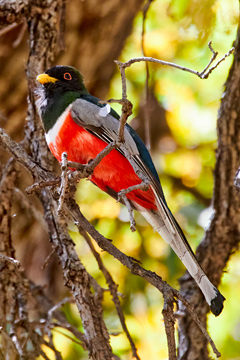
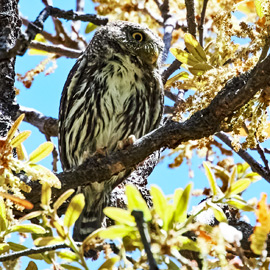
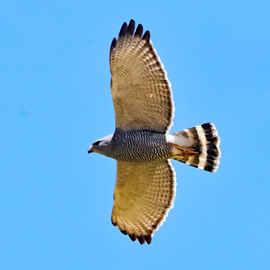 Following our last night in New Mexico we drove further west, basing ourselves in Sierra Vista. Our original plan was to visit Carr, Ramsey and Miller Canyons, but in the event we decided to skip the
long hike to see Spotted Owl in Miller Canyon, but just birded at the feeders at the bottom, which we visited on our first day, after a last few hours at Cave Creek and still missing Brown Creeper (there was one here a minute
ago honestly!). In truth birds weren't exactly dropping out of the trees, we found later that there had been a drought for a few years. Visiting Carr and Ash Canyons briefly we added a number of new
species to our list, especially woodpeckers, and our first Summer Tanager. We then made for Ramsey which seemed
our best bet for new species. However, arriving in the afternoon we found parking difficult so decided to return early the following day, and instead to investigate a new private area, Ramsey Canyon Cabins,
just before the entrance.
This proved to be a good decision, as we were the only birders around. The property consisted of a short trail and a number of overnight cabins, plus a feeder area, and had obviously only recently opened. There was
a small entrance fee but it turned out to be worth it since the owner had a White-eared Hummingbird visiting his feeder, a rarity and the only one of our trip. Other species recorded on that day included our first
Arizona Woodpecker and Gilded Flicker, a Calliope Hummingbird (unfortunately an immature since it was again the only one of the trip), our only positively identified Western Wood Pewee and a Swainson's Thrush.
The following day was spent mainly in the Carr Canyon area, we spent quite a lot of time looking for Rose-throated Becard, and failed, but we only had one report of a female, numbers this year were cetainly down.
An afternoon and evening spent near the Carr Canyon picnic area gave us our only Blue Grosbeak (quite rare in this area apparently). An extensive walk for a reported Harris' Sparrow was both exhausting and doomed to failure,
but did get us good views of Grey Hawk, and a Western Screech Owl appeared briefly in a tree behind the "visitor centre" Few other birds were new, Greater Pewee being an exception, but we did get superb photos
of a Macgillivray's Warbler, normally a bit of a skulker.
The next day we were out early to bird Ramsey Canyon, and this turned out to be our best day in the area. We were too early to pay for the car park so carried on and returned later, this seemed to be OK.
Initially we saw only birds we had seen before, but as more birders arrived we began to hear rumours of a trogon, and also knew that Mountain Pygmy-owls were in the area. This was when things became more
difficult, since the trogon was moving around, and whilst there was a tree containing two owls no-one seemed to be able to say exactly which tree. We looked for the trogon first, going to the top of the trail and to the place where
it was five minutes ago. We had no real option but to start to descend again, and of course Mike picked up his most-wanted species in flight! We followed the Elegant Trogon and it perched in a bush close to the trail
and began devouring caterpillars, enabling stunning views and good photographs. Of course people rapidly gathered, and despite trying to stop it the bird was soon disturbed and moved off again. So many people,
so little sense! The female remained in the background and again Mike found it, but we didn't bother telling anyone, she left with the male anyway.That left the matter of the Pygmy-owls, recently split from
Northern Pygmy-owl. We went to the warden and were given pecise directions to "the" tree. Unfortunately after spending about half an hour, assuming the birds were in their nest-hole, we discovered that they were
currently spending most of their time on the opposite side of the trail! Had we turned round we would have seen them, when we asked a group "what are you looking at?" they must have thought we were mad. Both birds
were present but partly hidden, careful moving to get the best camera angles resulted in some reasonable shots; the female had a lizard which was longer than her. Buff-breasted Flycatcher and Hutton's Vireo were new,
or at least newly identified, but we had got two of our major targets so were happy to leave early in preparation for our move to another area the next day.
Following our last night in New Mexico we drove further west, basing ourselves in Sierra Vista. Our original plan was to visit Carr, Ramsey and Miller Canyons, but in the event we decided to skip the
long hike to see Spotted Owl in Miller Canyon, but just birded at the feeders at the bottom, which we visited on our first day, after a last few hours at Cave Creek and still missing Brown Creeper (there was one here a minute
ago honestly!). In truth birds weren't exactly dropping out of the trees, we found later that there had been a drought for a few years. Visiting Carr and Ash Canyons briefly we added a number of new
species to our list, especially woodpeckers, and our first Summer Tanager. We then made for Ramsey which seemed
our best bet for new species. However, arriving in the afternoon we found parking difficult so decided to return early the following day, and instead to investigate a new private area, Ramsey Canyon Cabins,
just before the entrance.
This proved to be a good decision, as we were the only birders around. The property consisted of a short trail and a number of overnight cabins, plus a feeder area, and had obviously only recently opened. There was
a small entrance fee but it turned out to be worth it since the owner had a White-eared Hummingbird visiting his feeder, a rarity and the only one of our trip. Other species recorded on that day included our first
Arizona Woodpecker and Gilded Flicker, a Calliope Hummingbird (unfortunately an immature since it was again the only one of the trip), our only positively identified Western Wood Pewee and a Swainson's Thrush.
The following day was spent mainly in the Carr Canyon area, we spent quite a lot of time looking for Rose-throated Becard, and failed, but we only had one report of a female, numbers this year were cetainly down.
An afternoon and evening spent near the Carr Canyon picnic area gave us our only Blue Grosbeak (quite rare in this area apparently). An extensive walk for a reported Harris' Sparrow was both exhausting and doomed to failure,
but did get us good views of Grey Hawk, and a Western Screech Owl appeared briefly in a tree behind the "visitor centre" Few other birds were new, Greater Pewee being an exception, but we did get superb photos
of a Macgillivray's Warbler, normally a bit of a skulker.
The next day we were out early to bird Ramsey Canyon, and this turned out to be our best day in the area. We were too early to pay for the car park so carried on and returned later, this seemed to be OK.
Initially we saw only birds we had seen before, but as more birders arrived we began to hear rumours of a trogon, and also knew that Mountain Pygmy-owls were in the area. This was when things became more
difficult, since the trogon was moving around, and whilst there was a tree containing two owls no-one seemed to be able to say exactly which tree. We looked for the trogon first, going to the top of the trail and to the place where
it was five minutes ago. We had no real option but to start to descend again, and of course Mike picked up his most-wanted species in flight! We followed the Elegant Trogon and it perched in a bush close to the trail
and began devouring caterpillars, enabling stunning views and good photographs. Of course people rapidly gathered, and despite trying to stop it the bird was soon disturbed and moved off again. So many people,
so little sense! The female remained in the background and again Mike found it, but we didn't bother telling anyone, she left with the male anyway.That left the matter of the Pygmy-owls, recently split from
Northern Pygmy-owl. We went to the warden and were given pecise directions to "the" tree. Unfortunately after spending about half an hour, assuming the birds were in their nest-hole, we discovered that they were
currently spending most of their time on the opposite side of the trail! Had we turned round we would have seen them, when we asked a group "what are you looking at?" they must have thought we were mad. Both birds
were present but partly hidden, careful moving to get the best camera angles resulted in some reasonable shots; the female had a lizard which was longer than her. Buff-breasted Flycatcher and Hutton's Vireo were new,
or at least newly identified, but we had got two of our major targets so were happy to leave early in preparation for our move to another area the next day.
Saturday 30th April and Sunday 1st May
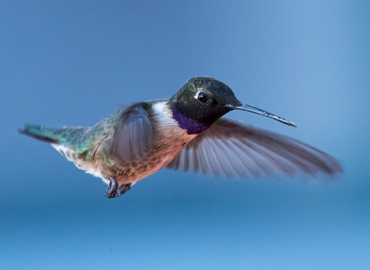
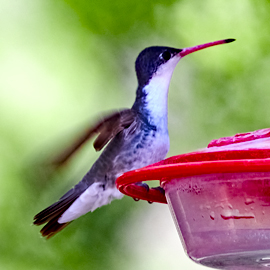 Our first port of call was the famous Patagonia rest-halt, which has attracted many rarities over the years, being close to the southern border of the state. This is just a large layby but
in a well wooded area set back from the road, just outside the town of Patagonia. We weren't lucky with
any rarities, but as we had missed the main migration period we were only visiting in the hope of seeing Thick-billed Kingbird, a rare breeder in the area. Almost the first bird we saw was the
Kingbird, singing from a treetop, although it didn't stay long and it flew in to cover where we only glimpsed it occasionally. I was unsuccessful in my efforts to photograph it, and we saw little else
except our first Warbling Vireos and a few commoner warblers. It was really the wrong time of day and was getting uncomfortably hot, so we were soon
off to another set of hummingbird feeders, this time a private garden which has been left to the Tuscon Audubon Society, and has become well-known as the Paton Centre. A short drive from the rest-halt,
the hummingbird feeders here are known throughout the birding world. A large number of birds are found in the area, and there are trails nearby
which can be birded, whilst the hottest part of the day can be spent sitting in front of the feeders in the shade. https://tucsonaudubon.org/paton-center-history/ is the link if you want to know
more
Our first port of call was the famous Patagonia rest-halt, which has attracted many rarities over the years, being close to the southern border of the state. This is just a large layby but
in a well wooded area set back from the road, just outside the town of Patagonia. We weren't lucky with
any rarities, but as we had missed the main migration period we were only visiting in the hope of seeing Thick-billed Kingbird, a rare breeder in the area. Almost the first bird we saw was the
Kingbird, singing from a treetop, although it didn't stay long and it flew in to cover where we only glimpsed it occasionally. I was unsuccessful in my efforts to photograph it, and we saw little else
except our first Warbling Vireos and a few commoner warblers. It was really the wrong time of day and was getting uncomfortably hot, so we were soon
off to another set of hummingbird feeders, this time a private garden which has been left to the Tuscon Audubon Society, and has become well-known as the Paton Centre. A short drive from the rest-halt,
the hummingbird feeders here are known throughout the birding world. A large number of birds are found in the area, and there are trails nearby
which can be birded, whilst the hottest part of the day can be spent sitting in front of the feeders in the shade. https://tucsonaudubon.org/paton-center-history/ is the link if you want to know
more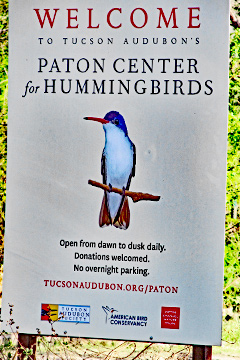 The "star" is possibly Violet-crowned Hummingbird, which is the emblem of the centre,
and we had little trouble in finding one. Unfortunately every time it appeared there was a sudden barrage of noise, not enough to flush it, but it always came to the same feeder and flew in at the
back, making photography difficult. We thought there was a second immature bird, but although we didn't call it to keep things quiet, it spent even less time there. Other hummers were
Broad-billed and Black-chinned, as in many places, but also Anna's, which are rarer in Arizona. However, the constant appearence of large numbers kept us happy for quite some time, especially as
females aren't so easily identified. There are also other feeders in the yard, which attracted Lazuli Buntings, Ladder-backed and Hairy Woodpeckers, Yellow-browed Chat and Summer Tanager.
Notable were numbers of Inca and Common Ground-doves, and walking the dried up stream bed behind the centre gave Mike a brief view of Ruddy Ground-dove, which is a vagrant, although I have
seen them in other countries. A new species was found, Northern Beardless Tyrannulet, and in general the birding was excellent, notable being Abert's Towhee, Lark Sparrow, Scott's Oriole
and several raptors, Cooper's, Grey and Swainson's Hawks and our first Black Vultures, far less common than Turkey. The hoped-for Zone-tailed Hawk didn't materialise, but tomorrow was another day.
That evening we stayed at the Spirit Tree Inn, which is well known to US birders and attracts birds generally, and also has an Elf Owl nest in the garden, which we missed on our
first evening but arranged a visit the following evening. The owner shows birders the owls, we were lucky in that it was the last time that "season". Many other birds frequent the area, especially
Gambell's Quail, but none is particularly oustanding, it's just a nice place to stay.The following day was a repeat of the previous,
we originally had planned to visit California Gulch to see Buff-collared Nightjar, but there had been few reports this year, and as it is a difficult area to access, on unmade roads, we decided to
give it a miss. We had seen most of what we expected in Arizona so far, so had a gentle day watching the feeders and doing a little general birding. There was one major moment however, when we saw,
at last, a Zone-tailed Hawk. These birds actually "mimic"
vultures in flight, and it is said to be easy to overlook them. However we had no such problems, and our sighting was followed by a second, more distant bird. Another Red-tailed Hawk was seen, and
our raptor tally at the end of the day was eighteen. The only expected bird we missed was Harris' Hawk, quite why I don't know, as Ann & I had seen them in Arizona previously. A new bird came in
the shape of Warbling Vireo, but we had seen plenty in the east so weren't too excited. We returned early to eat and go for the Elf Owl. After a long wait the male eventually exited the nest and
perched briefly in the nearby bush, whence it flew off to hunt. A number of Common Poorwills were heard calling, but we never managed to see one.
The "star" is possibly Violet-crowned Hummingbird, which is the emblem of the centre,
and we had little trouble in finding one. Unfortunately every time it appeared there was a sudden barrage of noise, not enough to flush it, but it always came to the same feeder and flew in at the
back, making photography difficult. We thought there was a second immature bird, but although we didn't call it to keep things quiet, it spent even less time there. Other hummers were
Broad-billed and Black-chinned, as in many places, but also Anna's, which are rarer in Arizona. However, the constant appearence of large numbers kept us happy for quite some time, especially as
females aren't so easily identified. There are also other feeders in the yard, which attracted Lazuli Buntings, Ladder-backed and Hairy Woodpeckers, Yellow-browed Chat and Summer Tanager.
Notable were numbers of Inca and Common Ground-doves, and walking the dried up stream bed behind the centre gave Mike a brief view of Ruddy Ground-dove, which is a vagrant, although I have
seen them in other countries. A new species was found, Northern Beardless Tyrannulet, and in general the birding was excellent, notable being Abert's Towhee, Lark Sparrow, Scott's Oriole
and several raptors, Cooper's, Grey and Swainson's Hawks and our first Black Vultures, far less common than Turkey. The hoped-for Zone-tailed Hawk didn't materialise, but tomorrow was another day.
That evening we stayed at the Spirit Tree Inn, which is well known to US birders and attracts birds generally, and also has an Elf Owl nest in the garden, which we missed on our
first evening but arranged a visit the following evening. The owner shows birders the owls, we were lucky in that it was the last time that "season". Many other birds frequent the area, especially
Gambell's Quail, but none is particularly oustanding, it's just a nice place to stay.The following day was a repeat of the previous,
we originally had planned to visit California Gulch to see Buff-collared Nightjar, but there had been few reports this year, and as it is a difficult area to access, on unmade roads, we decided to
give it a miss. We had seen most of what we expected in Arizona so far, so had a gentle day watching the feeders and doing a little general birding. There was one major moment however, when we saw,
at last, a Zone-tailed Hawk. These birds actually "mimic"
vultures in flight, and it is said to be easy to overlook them. However we had no such problems, and our sighting was followed by a second, more distant bird. Another Red-tailed Hawk was seen, and
our raptor tally at the end of the day was eighteen. The only expected bird we missed was Harris' Hawk, quite why I don't know, as Ann & I had seen them in Arizona previously. A new bird came in
the shape of Warbling Vireo, but we had seen plenty in the east so weren't too excited. We returned early to eat and go for the Elf Owl. After a long wait the male eventually exited the nest and
perched briefly in the nearby bush, whence it flew off to hunt. A number of Common Poorwills were heard calling, but we never managed to see one.
Monday 2nd May to Wednesday 4th May
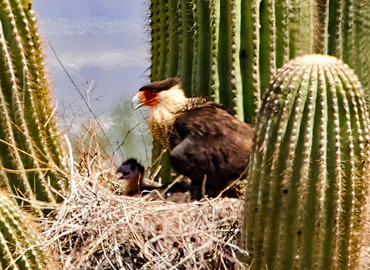
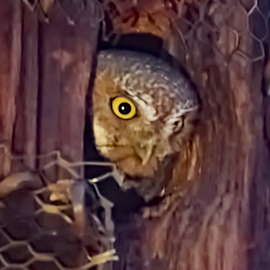 We next proceeded to the famous Madera Canyon area, which was to be a highlight of our trip. Sadly this wasn't to be, and bird numbers were low, again due to the drought. The feeders attracted
the usual species, Yellow-eyed Junco, Mexican Jay, Arizona Woodpecker, Canyon Towhee, and hummingbirds and butterflies but numbers were reduced, the hummingbirds were few as were butterflies,
compared to my previous visit a couple of years previously. Still an area worth birding, but much harder than normal. We spent three days in the area, but very
little at the Canyon itself during the day. Madera is famous for owls, but whereas earlier in the year we had been able to judiciously use "phone-calls" there
were too many visitors in early May. We heard several species, but managed to see only Elf Owl, which we were invited to view courtesy of the owners of the lodge, as
the nest hole is right outside their house. We had good views, but it steadfastly refused to air its wings. On a tip-off we proceeded to the top of the road,
were we did manage to see several Mexican Whip-poor-will against a moonlight sky, and heard more screech-owls, but Mike was beginning to tire in the evenings
due to his illness, so we didn't repeat the owling.There were still plenty of birds about, just not as many as usual, only one, Black-tailed Gnatcatcher,
was new although we weren't really expecting any. Rivoli's and Broad-billed Hummers, Yellow-eyed Junco, Painted Redstart, Coyote and White-tailed Deer were the highlights,
even the butterflies were thin on the ground. On our second day we went to nearby Box Canyon in the hope of a couple of sparrows. Black-chinned refused to
come out of cover, but we did manage a couple of brief views of Five-striped Sparrow, a speciality previously confined to California Gulch but expanding its
range slightly. We also had another Zone-tailed Hawk somewhere, but I don't remember the location. Our last day in the area resulted from information, partly from
another birder and partly from e-bird. It turned out there was a Crested Caracara nest with chicks not a million miles away, and easily viewed from the road. We found
the location quite easily and the bird had nested in a saguaro, good job we had fairly precise directions as there are a lot of said cactus. Neither of us had expected this,
indeed it was our only "write-in" and although they are quite common in Texas they remain uncommon in Arizona. A tick for Mike, it came as a pleasant surprise after the
relative disappointment of Madera Canyon.
We next proceeded to the famous Madera Canyon area, which was to be a highlight of our trip. Sadly this wasn't to be, and bird numbers were low, again due to the drought. The feeders attracted
the usual species, Yellow-eyed Junco, Mexican Jay, Arizona Woodpecker, Canyon Towhee, and hummingbirds and butterflies but numbers were reduced, the hummingbirds were few as were butterflies,
compared to my previous visit a couple of years previously. Still an area worth birding, but much harder than normal. We spent three days in the area, but very
little at the Canyon itself during the day. Madera is famous for owls, but whereas earlier in the year we had been able to judiciously use "phone-calls" there
were too many visitors in early May. We heard several species, but managed to see only Elf Owl, which we were invited to view courtesy of the owners of the lodge, as
the nest hole is right outside their house. We had good views, but it steadfastly refused to air its wings. On a tip-off we proceeded to the top of the road,
were we did manage to see several Mexican Whip-poor-will against a moonlight sky, and heard more screech-owls, but Mike was beginning to tire in the evenings
due to his illness, so we didn't repeat the owling.There were still plenty of birds about, just not as many as usual, only one, Black-tailed Gnatcatcher,
was new although we weren't really expecting any. Rivoli's and Broad-billed Hummers, Yellow-eyed Junco, Painted Redstart, Coyote and White-tailed Deer were the highlights,
even the butterflies were thin on the ground. On our second day we went to nearby Box Canyon in the hope of a couple of sparrows. Black-chinned refused to
come out of cover, but we did manage a couple of brief views of Five-striped Sparrow, a speciality previously confined to California Gulch but expanding its
range slightly. We also had another Zone-tailed Hawk somewhere, but I don't remember the location. Our last day in the area resulted from information, partly from
another birder and partly from e-bird. It turned out there was a Crested Caracara nest with chicks not a million miles away, and easily viewed from the road. We found
the location quite easily and the bird had nested in a saguaro, good job we had fairly precise directions as there are a lot of said cactus. Neither of us had expected this,
indeed it was our only "write-in" and although they are quite common in Texas they remain uncommon in Arizona. A tick for Mike, it came as a pleasant surprise after the
relative disappointment of Madera Canyon.
Thursday 5th May to Friday 5th May
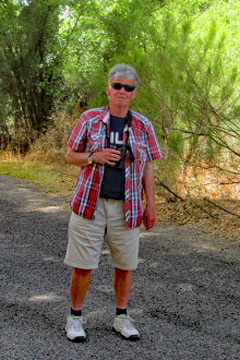
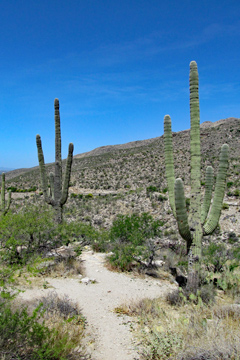 So eventually our somewhat mammoth trip came to and end, and we had to make our way back to Los Angeles over the next two days. We had a couple of places worth
visiting on our route back, and began by visiting the well-known Arizona-Sonora museum. Not expecting too much, the museum has a trail in typical desert habitat
where a number of reptiles in particular can be seen, including Gila Monster (no-we didn't). Birds are also present, such as Verdin, Gila Woodpecker and Gilded
Flicker, and it is a regular site for Costa's hummingbird. An interesting morning was followed by an uneventful drive to our overnight stop at Blythe. There was
a reason for stopping there, in that there is a Thrasher site not too far away which is obviously best visited early in the morning. We duly arrived at what
is basically a deserted piece of land with lots of scrubby bushes and not a lot else, you wouldn't suspect it was the main site in Arizona for several species of
Thrasher. Birds weren't obvious, but we did manage to see briefly several thrashers,
one of which was the much-wanted Le Contes. I had looked for these on more than one occasion but they are very secretive, they will fly short distances straight
in to thick undergrowth. Thus it was on this occasion, flight views only. They are much easier early in the year when they will sing from the top of bushes in
the early morning, but then many other species would be missed. Because of our early start we still had time for some birding so we visited a site close
enough to Los Angeles to get the car back on time. This was just general birding on spec. but it gave us yet another woodpecker, Nuttall's, a total of eleven
for the trip. Other species included Tree Swallow, Wood Duck and Red-tailed Hawk, but all too soon it was time to tackle the horrendous traffic back to LA. After
dropping off the hire car we were close enough to a shuttle to get to the airport, but walking in LA is a nightmare. However we got our flight on time and
encountered no further problems, but I won't fly in or out of LA again.
So eventually our somewhat mammoth trip came to and end, and we had to make our way back to Los Angeles over the next two days. We had a couple of places worth
visiting on our route back, and began by visiting the well-known Arizona-Sonora museum. Not expecting too much, the museum has a trail in typical desert habitat
where a number of reptiles in particular can be seen, including Gila Monster (no-we didn't). Birds are also present, such as Verdin, Gila Woodpecker and Gilded
Flicker, and it is a regular site for Costa's hummingbird. An interesting morning was followed by an uneventful drive to our overnight stop at Blythe. There was
a reason for stopping there, in that there is a Thrasher site not too far away which is obviously best visited early in the morning. We duly arrived at what
is basically a deserted piece of land with lots of scrubby bushes and not a lot else, you wouldn't suspect it was the main site in Arizona for several species of
Thrasher. Birds weren't obvious, but we did manage to see briefly several thrashers,
one of which was the much-wanted Le Contes. I had looked for these on more than one occasion but they are very secretive, they will fly short distances straight
in to thick undergrowth. Thus it was on this occasion, flight views only. They are much easier early in the year when they will sing from the top of bushes in
the early morning, but then many other species would be missed. Because of our early start we still had time for some birding so we visited a site close
enough to Los Angeles to get the car back on time. This was just general birding on spec. but it gave us yet another woodpecker, Nuttall's, a total of eleven
for the trip. Other species included Tree Swallow, Wood Duck and Red-tailed Hawk, but all too soon it was time to tackle the horrendous traffic back to LA. After
dropping off the hire car we were close enough to a shuttle to get to the airport, but walking in LA is a nightmare. However we got our flight on time and
encountered no further problems, but I won't fly in or out of LA again.
|












